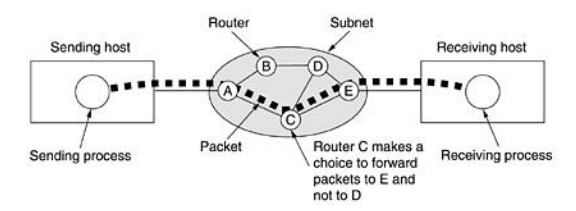A wide area network, or WAN, covers a large geographical area, generally a country or continent. It have a collection of machines intended for running user (i.e., application) programs. These machines are known as hosts. The hosts are linked by a communication subnet, or just subnet for short time. The hosts are owned by the clientele (e.g., people's private computers), whereas the communication subnet is totally owned and operated by the telephone company or the Internet service provider. The work of the subnet is to take messages from host to host, just as the telephone system takes words from speaker to listener. Separation of the communication aspects of network (the subnet) from the application aspects, greatly simplifies the whole network design.
In most wide area networks, the subnet comprises of the two distinct components:
1) transmission lines and
2) switching elements.
The transmission lines move bits between the machines. They can be made out of copper wire, optical fibre, or radio links. In most of the WANs, the network contains number of transmission lines, each one connecting a pair of routers. If two routers which do not share a transmission line wish to communicate, they must perform this indirectly, via other routers. When a packet is sent from one router to another router through one or more intermediate routers, the packet is received at every intermediate router in its entirety, saved there until the desired output line is free, and then is forwarded. A subnet organized according to this principle is known as a store-and- forward or packet-switched subnet. Practically all wide area networks (excluding those using satellites) have store-and-forward subnets. When the packets are very small and all the same size, they are commonly called as cells.
The principle of the packet-switched WAN is so very important. Generally, when a process on some host has a note to be sent to a practice on some other host, the sending host first divides the message into packets, each one bearing its number in the series. These packets are then injected into network one at the time in rapid succession. The packets are transported separately over the network and deposited at the receiving host side, where they are reassembled into the original note and delivered to the receiving process. A stream of packets resulting from some primary message is given and explained. In the figure, all the packets follow the course ACE, rather than ABDE or ACDE. In some networks all the packets from a given note must follow the same course; in others each packed is routed individually. Of course, if ACE is the best route of all, all packets may be sent through it, even if each packet is separately routed.

All the WANs are not packet switched. A next possibility for a WAN is the satellite system. Each router has a specific antenna through which it can send and receive the data. All routers can perceive sound the output from the satellite, and in some cases they can also perceive sound the upward transmissions of their fellow routers to the satellite as well. Sometimes the routers are linked to a substantial point-to-point subnet, with only some of them having the satellite antenna. Satellite networks are inherently broadcast and are mainly useful when the broadcast property is important.